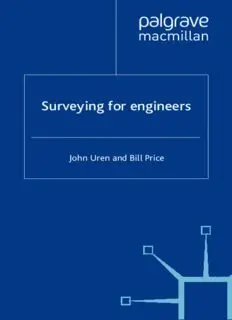Table Of ContentSurveying for engineers
John Uren and Bill Price
Surveying for engineers
John Uren
School of Civil Engineering
University of Leeds
Bill Price
Formerly of the School of the Environment
University of Brighton
5th edition
©JohnUrenandBillPrice1978,1985,1994,2006and2010
Allrightsreserved.Noreproduction,copyortransmissionofthis
publicationmaybemadewithoutwrittenpermission.
Noparagraphofthispublicationmaybereproduced,copiedortransmitted
savewithwrittenpermissionorinaccordancewiththeprovisionsofthe
Copyright,DesignsandPatentsAct1988,orunderthetermsofanylicence
permittinglimitedcopyingissuedbytheCopyrightLicensingAgency,90
SaffronHouse,6–10KirbyStreet,LondonEc18TS.
Anypersonwhodoesanyunauthorisedactinrelationtothispublication
maybeliabletocriminalprosecutionandcivilclaimsfordamages.
Theauthorshaveassertedtheirrightstobeidentified
astheauthorsofthisworkinaccordancewiththeCopyright,Designs
andPatentsAct1988.
Firstedition1978
Secondedition1985
Thirdedition1994
Fourthedition2006
Thisedition2010
Publishedby
PALGRAVEMACMILLAN
PalgraveMacmillanintheUKisanimprintofMacmillanPublishersLimited,
registeredinEngland,companynumber785998,ofHoundmills,Basingstoke,
HampshireRG216XS
PalgraveMacmillanintheUSisadivisionofSt.Martin’sPressLLC,
175FifthAvenue,NewYork,NY10010
PalgraveMacmillanistheglobalacademicimprintoftheabovecompanies
andhascompaniesandrepresentativesthroughouttheworld
Palgrave®andMacmillan®areregisteredtrademarksintheUnitedStates,
theUnitedKingdom,Europeandothercountries.
ISBN:978–0–230–22157–4
Thisbookisprintedonpapersuitableforrecyclingandmadefromfully
managedandsustainedforestsources.Logging,pulpingandmanufacturing
processesareexpectedtoconformtotheenvironmentalregulationsofthe
countryoforigin.
AcataloguerecordforthisbookisavailablefromtheBritishLibrary.
AcatalogrecordforthisbookisavailablefromtheLibraryofCongress.
10 9 8 7 6 5 4 3 2 1
15 14 13 12 11 10 09 08 07 06
PrintedandboundinGreatBritainby
CPIAntonyRoweLtd,ChippenhamandEastbourne
Contents
Preface vii
Acknowledgements ix
Chapter 1 Introduction 1
1.1 Engineeringsurveying 2
1.2 Surveyinstitutionsandorganisations 19
Chapter 2 Levelling 27
2.1 Heights,datumsandbenchmarks 28
2.2 Levellingequipment 32
2.3 Fieldprocedureforlevelling 45
2.4 Calculatingreducedlevels 48
2.5 Precisionoflevelling 52
2.6 Sourcesoferrorinlevelling 53
2.7 Otherlevellingmethods 57
Chapter 3 Angle measurement 65
3.1 Definitionofhorizontalandverticalangles 66
3.2 Accuracyofanglemeasurement 68
3.3 Electronictheodolites 69
3.4 Opticaltheodolites 77
3.5 Measuringandsettingoutangles 79
3.6 Sourcesoferrorwhenmeasuringandsettingoutangles 91
Chapter 4 Distance measurement: taping 102
4.1 Measurementsandmethods 103
4.2 Equipmentandfieldworkfortaping 105
4.3 Systematicerrorsintaping 109
4.4 Precisionandapplicationsoftaping 116
4.5 Steeltapingworkedexamples 117
Chapter 5 Total stations 124
5.1 Integratedtotalstations 125
5.2 Electromagneticdistancemeasurement 127
5.3 Instrumentation 142
5.4 Electronicdatarecordingandprocessing 154
iv Contents
5.5 Sourcesoferrorfortotalstations 162
5.6 Measuringheights(reducedlevels)withtotalstations 173
Chapter 6 Traversing and coordinate calculations 182
6.1 Controlsurveys 183
6.2 Rectangularandpolarcoordinates 184
6.3 Coordinatetransformations 192
6.4 Planningandfieldworkrequiredfortraversing 194
6.5 Traversecalculations 205
6.6 Traversingwithtotalstations 225
6.7 Intersectionandresection 228
6.8 Controlnetworks 237
Chapter 7 Global Navigation Satellite Systems 247
7.1 ThedevelopmentofGNSS 248
7.2 ComponentsofGNSS 251
7.3 GPSpositioningmethods 256
7.4 ErrorsinGPS 261
7.5 DifferentialandrelativeGPS 269
7.6 SurveyingwithGNSS 275
7.7 GNSSinstrumentation 285
7.8 GNSSinengineeringsurveying 290
Chapter 8 National coordinates and transformations 304
8.1 Planesurveyingandgeodesy 305
8.2 Geoidsandellipsoids 306
8.3 HeightsfromGNSS 311
8.4 Referencesystemsandreferenceframes 312
8.5 GNSScoordinatesystems 314
8.6 OSNet 316
8.7 OrdnanceSurveyNationalGridandOrdnanceDatumNewlyn 323
8.8 Coordinatetransformations 338
Chapter 9 Measurements, errors and specifications 347
9.1 Errorsandresiduals 348
9.2 Precisionandaccuracy 351
9.3 Propagationofvariancesandstandarderrors 361
9.4 Surveyspecifications 370
9.5 Leastsquaresadjustment 377
Chapter 10 Detail surveying and mapping 385
10.1 Anintroductiontoplanproduction 386
10.2 Planningthesurvey 389
10.3 Plottingthecontrolnetwork 397
10.4 Detail 401
10.5 SurveyingdetailusingtotalstationsandGNSSequipment 404
Contents v
10.6 Contours 415
10.7 Thecompletedsurveyplan 418
10.8 Terrestriallaserscanning 421
10.9 Computer-aidedsurveymappinganditsapplications 427
10.10 Additionalmappingsystemsandproducts 441
10.11 Surveyingundergroundservices 455
Chapter 11 Setting out 462
11.1 Anintroductiontosettingout 463
11.2 Theaimsofsettingout 466
11.3 Theprinciplesofsettingout 474
11.4 Applyingtheprinciplesofsettingout 504
11.5 Settingoutusinglaserinstruments 529
11.6 Machinecontrol 547
11.7 Qualityassuranceandaccuracyinsurveyingandsettingout 555
11.8 Settingoutworkedexamples 563
Chapter 12 Circular curves 585
12.1 Horizontalcurves 586
12.2 Circularcurvesandtheirgeometry 587
12.3 Throughchainage 593
12.4 Designingcircularcurves 594
12.5 Introductiontosettingouthorizontalcurvesonsite 597
12.6 Settingoutcircularcurvesonsitebytraditionalmethods 599
12.7 Settingoutcircularcurvesonsitebycoordinatemethods 609
12.8 Circularcurveworkedexamples 612
Chapter 13 Transition curves 624
13.1 Theneedfortransitioncurves 625
13.2 Current United Kingdom Department of Transport design
standards 631
13.3 Typeoftransitioncurvetobeused 634
13.4 Thegeometryoftransitioncurves 641
13.5 Designingcompositeandwhollytransitionalcurves 648
13.6 Settingoutcompositeandwhollytransitionalcurves 656
13.7 Transitioncurveworkedexamples 664
Chapter 14 Vertical curves 683
14.1 Theneedforverticalcurves 684
14.2 Thetypeofverticalcurvetobeusedanditsgeometry 687
14.3 Thelengthofverticalcurvetobeused 692
14.4 Designingverticalcurves 698
14.5 Settingoutverticalcurvesonsite 702
14.6 Verticalcurveworkedexamples 703
vi Contents
Chapter 15 Earthwork quantities 715
15.1 Typesofearthworkquantities 716
15.2 Calculationofplanareas 717
15.3 Longitudinalsectionsandcross-sections 726
15.4 Calculatingvolumesfromcross-sections 739
15.5 Calculatingvolumesfromspotheightsandcontours 756
15.6 Masshauldiagrams 760
15.7 Computer-aidedearthworkcalculations 773
Appendix Surveying calculations 780
Answers to numerical exercises 788
Index 797
Preface
Itisnowmorethan30yearssincethepublicationofthefirsteditionofSurveyingfor
Engineers,andinthattimetheequipmentandtechniquesusedinengineeringsur-
veyinghaveundergoneincrediblechanges.Electronictheodolitesandtotalstations,
digitallevels,laserscannersandmachinecontrolsystems,tonamejustafew,wereall
unheardofwhenthefirsteditionwaspublishedin1978,whichbypurecoincidence
wasthesameyearthatthefirstGPSsatellitewaslaunched.Sincethenthediscipline
into which engineering surveying falls has developed almost beyond recognition,
havingevenbeengivenanewidentitywiththenameofGeomatics.Therecanbefew
disciplines that have changed so quickly and dramatically. Subsequent editions of
Surveyingfor Engineers have alwaystried to reflect this evolution and this new fifth
edition is no exception.
Satellitesurveyingsystemscontinuetohaveamajorinfluenceonengineeringsur-
veying and, to reflect this, recent developments in GlobalNavigation SatelliteSys-
tems (GNSS), particularlythe introduction of network RTK and OS Net,have been
included.Inaddition,thelatestsurveyinstruments,methodsanddigitaltechnolo-
giesarecovered, includingimageprocessingwithtotalstationsandlaserscanners,
developmentsindataprocessingandintegrationaswellasupdatesonOrdnanceSur-
veymappingproducts.Newtopicsincludetechniquesforlocatingundergroundser-
vicesandtheuseofEarthobservationsatellitesformappingincivilengineeringand
construction.
However,alongsideallofthesophisticatedequipmentcurrentlyavailable,funda-
mentaltopics such as levelling,measurement of angles, measuring distances using
tapesandhowtocarryouttraversingandcomputecoordinatesarestillcoveredin
somedetail,astheyarestillasrelevantonsitetodayastheywerein1978,asarethe
calculationsrequiredforcurves,areasandvolumes,whichhavealsobeenretained.
Thismixofmodernandwell-establishedtechniquesisoneoftheenduringfeatures
ofSurveyingforEngineersinthatitnotonlycoversthebasicskillsrequiredonsitebut
alsogivesdetailsofthelatesttechnologiesavailable.Thiseditionalsocontinuesthe
themeintroducedinthepreviousoneofmakingextensiveuseofInternetresources
throughoutanditishopedthattheadoptionofanewpageformatandlayoutwill
further enhance the appeal of this classic surveying textbook to students and
practitioners alike.
As with allprevious editions, the fifth edition of Surveyingfor Engineers has been
written with civil engineering, building and construction students in mind.
However,itwillalsobefoundusefulbyanyotherstudentswhoundertakesurveying
as an elective subject and it is anticipated that practising engineers and those
engaged in site surveying and construction will use Surveying for Engineers as a
reference text.
John Uren and Bill Price
February 2010
This page intentionally left blank
Acknowledgements
The authors wish to thank all those who have contributed in any way to the
preparationofthisbookand,inparticular,thefollowingpersonsandorganisations:
Barbara Molloy, Hayley Tear, PV Publications
Bernd Hildebrandt, Volker Schäpe, DMT GmbH & Co
Bob Wells, York Survey Supply Centre
British Standards Institution
Catherine Lefebvre, Pentax Europe
Chartered Institution of Civil Engineering Surveyors
Construction Industry Research and Information Association (CIRIA)
David Bennett, Trimble & KOREC Group
Dee Davis, Michelle Gauntlett, Ordnance Survey
Denise Nelson, General Dynamics
Department of Transport
Emmanuelle Tarquis, Trimble Survey Europe
Gordon Citrine, Citrine UK Ltd
Institution of Civil Engineers
International Organization for Standardization (ISO)
James Fitzhenry, ESS Safeforce
James Kavanagh, RICS
Jason Crossley, Blom Aerofilms Ltd
Jean Rüeger, University of New South Wales, Sydney, Australia
Joe Cox, Phoenix Surveying Equipment Ltd
John Robinson, Subscan Technology Ltd
John Strodachs, AiC
John van den Berg, The National Swedish Institute for Building Research
Jon Cline, Andrew Coleman, Sigma Seven Ltd
Jon Iliffe, University College, London
Karen Myhill, Fisco Tools Ltd
Katsumi Kaji, Ushikata Mfg, Co. Ltd., Tokyo, Japan
Michelle Hall, Rekha Voralia, Nathan Ward, Leica Geosystems
Michiel van Haaften, Sokkia BV
Nigel Lorriman, McCarthy Taylor Systems Ltd
Paul Cruddace, Ordnance Survey
Pauline Beck, AGL Corporation
Roger Whennell, GSR Laser Tools, Western Australia
Roy Trembath, University of Leeds
Stuart Edwards, University of Newcastle upon Tyne
Tony Rogers, APR Services Ltd
Topcon Ltd
Trevor Burton, Fugro-BKS

